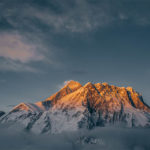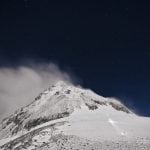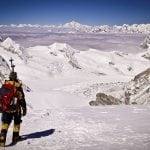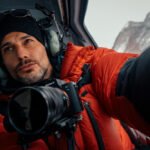Majestic mountains, stunning vistas, limitless time-lapse possibilities, Buddhist temples, beautiful children and the highest mountains on planet Earth! This is but a glimpse of what you experience while trekking through the Himalayas to Mt. Everest basecamp. With a DSLR camera in hand: the possibilities are truly infinite.
Last fall, I was contracted to shoot an expedition to Mt. Everest basecamp. A team of novices were planning to push themselves beyond their limits, step outside of their comfort zones and journey to the foot of the highest mountain on Earth: Mt. Everest basecamp at 17, 500ft above sea level. And of course, they wanted their journey documented every step of the way. Having previously reached the summit in 2010 and undertaken 4 Mt. Everest expeditions as an adventure filmmaker, apparently I was the man for the job. I happily accepted the offer with less than two weeks notice and found myself back in Nepal for the 7th time capturing the magic of the Himalayas in HD video.
How did I land this dream job you ask? It’s complicated. Let’s just say that 8 years ago, I made a bold decision to give up EVERYTHING to pursue a life of adventure. My car, my condo, my small video production business, I incurred huge personal loans and made gigantic sacrifices to invest all that I had into a resume and portfolio that I hoped others would take notice of. During this 8 year period there were times where I lived on tuna and chick peas, could barely pay my rent and repeatedly faced the possibility of bankruptcy. My plan at the time was to garner enough experience as an adventure filmmaker to gain the attention of potential clients who could hire me as a ‘high altitude filmmaker’ while earning the trust of school boards who would one day partner with my not for profit organization FindingLife – an organization that empowers, inspires and educates youth through technology and global adventures. I earn a living now as an adventure filmmaker and run this organization full time.
With two weeks notice, I packed up my Glidecam, Glidetrack, my arsenal of Canon DSLR cameras plus lenses, time-lapse remotes, tripods, guerilla pods and everything else I’d need to capture the magic of the Himalayas. On previous expeditions, I’d been using a a Cowboy studio rig as a hand held rig and a lower line LCD viewfinder adapter. Needless to say, I was not pleased with the results. I decided on a whim to reach out to Zacuto on the 11th hour and they happily loaned me some gear to test in the Himalayas. Within days I had a Zacuto EVF and a Fast Draw rig as part of my kit. Awesome! All I had to do was figure out how I was going to carry it all!
Some of the major challenges that you face in the high mountains is the altitude, the exposure and the extreme cold. The higher you climb, the less oxygen there is in the atmosphere and the harder it is to survive. While most struggle to place one foot in front of the other, as a high altitude filmmaker, you are responsible for your own safety and well-being in addition to creating beautiful images, telling a story while ensuring proper focus, exposure and framing. The best example I can illustrate in terms of how you feel at extreme altitude is this: stay up all night, ensure you’ve got a mild case of the flu, place a snorkeling mask on your head and run on a treadmill at full speed. Now operate a camera and be creative. Good times!
Now in this case, this team of novices were only climbing to Everest basecamp and I knew they’d be slow. For me, that meant that meant that I’d be able to bring some new toys with me to test out on the trail.
The Zacuto Fast Draw rig was a dream to use. It was the first time I had my hands on a professional DSLR camera rig and I found it to be incredibly steady, easy to mount and assemble and of course 100{c0d616ec23a1ea78237269fee999fd3e756e1235669a36003e38faaff0a7a27b} customizable. That combined with the Zacuto-EVF made for the perfect rig in the Himalayas. Coming from a background where I shot with proper video cameras, features like zebra and peaking are essential to how I shoot and I find that one of biggest drawbacks to DSLR’s is that these simple features simply do not exist, out of box. I often question my exposure while shooting on DSLR’s due to the untrusted light meter. The Zacuto-EVF helped me nail my exposure each and every time. The increased resolution and peaking also helped immensely, particularly when it came to pulling my own fine focus on hand held shots.
In this environment, it’s important to understand that no film-maker can work alone and carry all of this equipment while remaining healthy. The risks of working too hard can literally result in death. I’ve seen it all too many times. Cameramen that shoot at altitude for the first time, push too hard, have trouble acclimatizing, contract acute mountain sickness which can lead to pulmonary or cerebral edema where your brain and lungs fill with water. The only way to treat mountain sickness and edema is to descend to lower altitude. My strategy was simple: hire good porters, train them to manage the gear, handle the lenses, balance the Glidecam and follow me along the trails. These guys make it possible. They’re generally hired at approx $15-20 USD per day and rely on tips after the expedition is complete. They’re the kindest, most humble, giving and strongest people I have ever met. They’re backbone of my efforts and I couldn’t do what I do without them.
In the end, it was a privileged experience to share in this team’s journey. The struggled, they laughed, the pushed beyond their limits and they eventually reached their goal. The culmination was a summit of a mountain named Kalapattar where two of the team members braved the thin air, sported headlamps while climbing in the dark and literally sat on top of the peak at sunrise and witnessed the sun rise over the summit of Mt. Everest. A glorious moment filled with triumph, emotion and the understanding that their impossible dream had been achieved.
In retrospect, I realize that in the future, while on more intense high altitude expeditions that a lighter Zacuto hand held rig will be a better suited choice for me personally. The EVF has become a part of my kit and I’m now a loyal Zacuto fan. I certainly appreciate their support and look forward to their future products.
As a high altitude adventure filmmaker, I’m always on the look out for life inspiring stories of the human spirt that take place in the most challenging of environments. This spring, I’ll be back on Everest, this time climbing to the very top of the world to shoot a TV series for a Network in the Middle East. That adventure will be followed by a project I’ve been pouring my heart into for the past 4 years, a historical film called ‘The Untold Legend’ aimed at inspiring Native youth through the telling one of North American’s greatest untold stories.
You can learn more about my work at www.eliasaikaly.com
More about my not for profit work at www.findinglife.ca





